2ND LIEUTANANT KILLS/WOUNDS 50 ENEMY
Near Holtzwihr, Colmar Pocket, Northeastern France • January 26, 1945
On this date in 1945 U.S. Army Second Lt. Audie Murphy, age 20, commanded an infantry company when it came under attack from 200 German infantrymen and a half-dozen Mark VI Tiger tanks of the German Nineteenth Army on the outskirts of Holtzwihr (now part of Porte-du-Ried), a village near Colmar on the eastern slopes of the wintry Vosges Mountains in Northeastern France. Armed with a .30 caliber/7.62 mm, semi-automatic M1 carbine and a radio, Murphy called in artillery fire on his own position. When enemy tanks and infantry continued to approach, Murphy, who had initially been rejected by both the U.S. Marine Corps, U.S. Navy, and U.S. Army because he was too short (5 ft, 6 in/1.67 m) and was underweight, scampered aboard a burning American M10 tank destroyer and fired a .50 caliber/12.7 mm machine gun against an armor-infantry opponent advancing on 3 sides through swirling smoke and snow, single-handedly turning it back and inflicting 50 casualties. Wounded in the leg the previous day, the consummate rifleman held the enemy off for 3 hours. Some came within 10 yards/9.1 meters of Murphy. After exhausting his ammunition, he limped back to his company and led a full-man charge, forcing the Germans to retreat. For his extraordinary courage, Murphy received the Medal of Honor, the highest military award for bravery that can be given to any person in the United States.
During his 3 years of active service in 9 major campaigns across the European Theater (North Africa, Sicily, Italy, France, and Germany), Murphy was credited by the U.S. Army with killing over 240 enemy soldiers while wounding more than 500 and capturing about 100. He became the most decorated soldier in U.S. history. Among his 33 medals, ribbons, citations, and badges were 1 Belgian and 5 French medals, including the French Legion of Honor and the French Croix de Guerre. When he left active service with the rank of first lieutenant, Murphy was still under 21. His 1949 autobiographical account of his service, To Hell and Back, was a best seller.
Diagnosed with “battle fatigue” while still in the army, Murphy suffered from post-traumatic stress disorder (PTSD) after returning home. He struggled with insomnia and depression and sought professional help. A doctor prescribed Placidyl, a strong sedative, which inadvertently led to addiction. Isolating himself in a motel room for a week without any medication, he detoxed himself. Murphy became a vocal advocate for mental health, especially for returning veterans from wars in Korea and Vietnam. He candidly shared his own struggles with mental health and called on the U.S. government to prioritize research into the psychological effects of combat. He also worked on behalf of troubled children.
With Hollywood good looks, Murphy enjoyed a long film career (44 films), which included playing himself in a film biography released by Universal-International in 1955 with the same title as the book. The movie version held the record as Universal’s highest-grossing picture until 1975, when the movie Jaws surpassed it. Twice married, the father of 2 sons whom he adorned, Murphy wrote poems and lyrics for country-and-western songs, raised thoroughbred horses, and joined the Shriners best known for their hospitals. Late in life Murphy faced financial challenges and was pursued by the Internal Revenue Service for outstanding tax debts.
Murphy died 3 weeks short of his 46th birthday in a private plane crash on the side of a mountain near Roanoke, Virginia, on May 28, 1971. Fittingly, his body was recovered 2 days later on Memorial Day. He is buried in Arlington National Cemetery outside Washington, D.C. His gravesite near the amphitheater is the second most popular destination after President John F. Kennedy’s. Notwithstanding his tragic and untimely death, Murphy may very well be remembered as the last genuine American Hero.
Audie Murphy: To Hell and Back
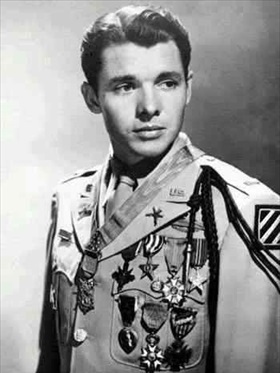 | 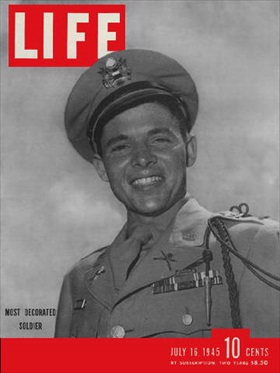 |
Above: Seventh of 12 children of a dirt-poor Texas sharecropper and a grade school dropout at age 9, Audie Murphy (1925–1971) enlisted in the U.S. Army in June 1942. He was the recipient of 33 medals, ribbons, citations, and badges, more than had any other soldier in his country’s history, many of them more than once, and most of them awarded before he had turned 21. Medals included the Medal of Honor, Distinguished Service Cross, Silver Star with oak leaf cluster, Bronze Star with cluster, Purple Heart with cluster, Legion of Merit, the prized Combat Infantryman Badge, French Legion of Honor, French Croix de Guerre with Palm and Star, French Liberation Medal, and Belgian Croix de Guerre with Palm. He appeared next to the caption “Most Decorated Soldier” on the cover of Life Magazine for July 16, 1945.
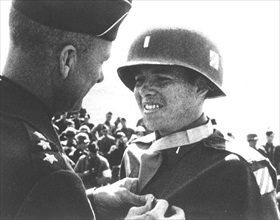 | 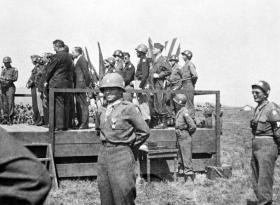 |
Left: On June 2, 1945, near Salzburg, Austria, U.S. Seventh Army commander Lt. Gen. Alexander Patch presented (now) 1st Lt. Audie Murphy with the Medal of Honor and the Legion of Merit for his actions at Holtzwihr, France, 5 months earlier. The official U.S. Army citation for Murphy’s Medal of Honor read in part: “His [Murphy’s] directing of artillery fire wiped out many of the enemy; he killed or wounded about 50. 2d Lt. Murphy’s indomitable courage and his refusal to give an inch of ground saved his company from possible encirclement and destruction, and enabled it to hold the woods which had been the enemy’s objective.”
![]()
Right: A photo taken by a Red Cross worker shows the doughty 19‑year‑old Texan standing in the foreground as Lt. Gen. Patch reads the U.S. Army citation from the makeshift platform on June 2. Years after the war Murphy was asked by a reporter how the Army could have arrived at the casualty figures he supposedly inflicted on the enemy. “I don’t know how they know,” he replied. “Maybe the War Department kept count somehow. Maybe the officers sent in totals. I didn’t keep count. I don’t know how many. I don’t want to know.” In a subsequent interview when asked the question, “How does it feel to have killed 240 men?” Murphy retorted: “To begin with, I didn’t kill that many; how the hell does anyone think it felt. It didn’t feel either way; good or bad. Feeling wasn’t a luxury in the infantry.”
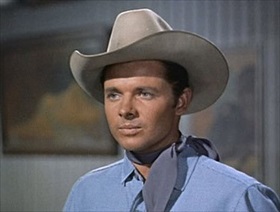 | 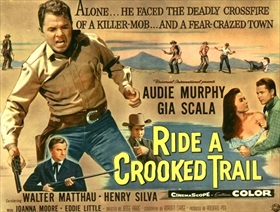 |
Above: With his natural intelligence, facility for assessing combat situations, and fighting spirit, Audie Leon Murphy rose from the rank of private to become a company commander in 30 months with the veteran Third “Rock of the Marne” Infantry Division of World War I fame. After the war Murphy went on to a successful career as a film star, appearing in 44 feature films and 29 television episodes in 21 years, most of them low-budget Westerns in the 1950s and 1960s. But the war years haunted him all his short life. In a 1955 interview at the time of the release of his autobiographical film To Hell and Back, in which he played himself, Murphy remarked ruefully: “War is like a giant pack rat. It takes something from you and leaves something behind in its stead. It burned me out in some ways so that now I feel like an old man. . . . It made me grow up too fast. You live so much on nervous excitement that when it is over, you fall apart. That’s what war took from me, the excitement of living.” Asked in an interview near the end of his life, “How does a soldier get over a war,” Murphy lowered his head and in a barely audible voice said, “I don’t think they ever do.”
Excellent Documentary on Audie Murphy, 1925–1971
![]()

 History buffs, there is good news! The Daily Chronicles of World War II is now available as an ebook for $4.99 on Amazon.com. Containing a year’s worth of dated entries from this website, the ebook brings the story of this tumultuous era to life in a compelling, authoritative, and succinct manner. Featuring inventive navigation aids, the ebook enables readers to instantly move forward or backward by month and date to different dated entries. Simple and elegant! Click
History buffs, there is good news! The Daily Chronicles of World War II is now available as an ebook for $4.99 on Amazon.com. Containing a year’s worth of dated entries from this website, the ebook brings the story of this tumultuous era to life in a compelling, authoritative, and succinct manner. Featuring inventive navigation aids, the ebook enables readers to instantly move forward or backward by month and date to different dated entries. Simple and elegant! Click 











